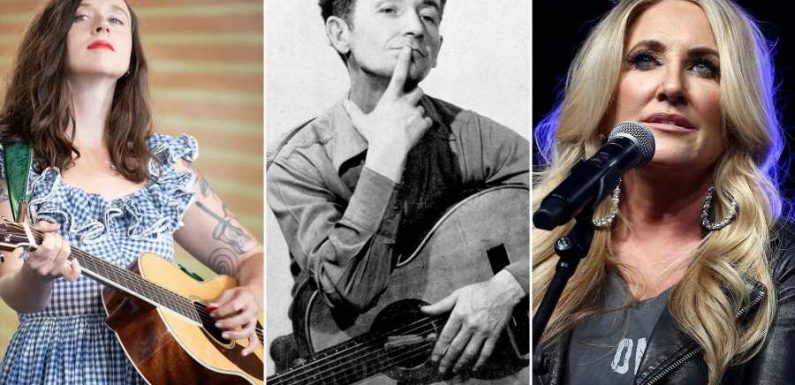
Drought, unemployment, unstable weather, ruined crops, decimated farmers: In retrospect, the devastating Dust Bowl of the Thirties sounds like a precursor to America in the Covid-19 era. Aptly, the album that chronicled those hard years in the Southern Plains in real-time is making a comeback of its own.
Just in time for another national crisis comes Home in This World: Woody Guthrie’s Dustbowl Ballads, a track-by-track remake of Guthrie’s album Dust Bowl Ballads. Likely one of the first concept albums in music history, Guthrie’s 1940 album was inspired by that historic and devastating confluence of events. Originally released as two separate 10-inch 78-rpm mini-albums, it was reissued in the Sixties as a complete LP, and some of its songs — “I Ain’t Got No Home in This World Anymore,” the outlaw ballad “Pretty Boy Floyd,” narratives like “Dusty Old Dust” (with its “so long, it’s been good to know you” refrain) and the Grapes of Wrath-inspired “Tom Joad” — became some of Guthrie’s best known.
The new version of the Guthrie record, due September 10th, features an eclectic range of contributors. Versions by country and Americana acts (Lee Ann Womack’s “Dusty Old Dust,” Colter Wall’s “Do Re Mi,” the Secret Sisters’ “Dust Cain’t Kill Me,” Chris Thile’s “Tom Joad Part 1”) sit alongside remakes by indie and underground types like Waxahatchee (“Talking Dust Bowl Blues”), Mark Lanegan (“Dust Pneumonia Blues”), Swamp Dogg (“Dust Bowl Refugee”), and the Felice Brothers (“The Great Dust Storm”).
Home in This World was the brainchild of producer Randall Poster, who has organized numerous tribute albums and worked as a music supervisor on The Queen’s Gambit, Tiger King, the Questlove-directed doc Summer of Soul, and an upcoming Velvet Underground doc. (Next up: Music for Martin Scorsese’s upcoming Killers of the Flower Moon, Wes Anderson’s The French Dispatch, and the Olivia Wilde-directed Don’t Worry Darling).
Despite its connection to modern times, Home in This World didn’t originate the way one would have thought. While putting together Hanukkah+, a collection of songs about that holiday that included tracks from Haim and the Flaming Lips, Poster realized that Guthrie, whose wife Marjorie was Jewish, had written Hanukkah tunes himself. That in turn led Poster to delve back into Guthrie’s work. (As Poster says, explaining the origins of Home in This World, “Bet you didn’t expect that answer.”)
In turn, his rediscovery of Guthrie led him to Dust Bowl Ballads, the album Guthrie recorded in a single day in a studio in New Jersey. Inspired in part by modern events and John Steinbeck’s The Grapes of Wrath, the album was Guthrie’s first (and only) major label release, for RCA, and still stands as one of his greatest works. “What prompted the Dust Bowl is that the land was exploited and didn’t lay fallow for any period of time, which lead to this tragedy and migration,” Poster says. “That’s where I started to make certain connections and realized that Woody’s messaging was very relevant in this day and age.”
The Dust Bowl Ballads idea was clinched when Poster visited Birmingham, Alabama, two years ago and caught the Lost Dog Street Band, an Americana trio, performing “I Ain’t Got No Home in This World Anymore.”
For contributors, Poster pulled together artists with whom he’d worked before — like Womack, Thile, and Shovels & Rope, who contributed to his album of Civil War songs — and others he hadn’t, like Oklahoma-based singer-songwriter Parker Millsap. For the part-two version of “Tom Joad,” he recruited Lillie Mae, the singer and fiddler who played on recent Jack White solo albums and was also in his all-female band. Two of the album’s most left-field tracks — Lanegan’s typically crunchy, brooding “Dust Pneumonia Blues” and Swamp Dogg’s soul recasting of “Dust Bowl Refugee” — were produced by George Drakoulias and Brendan O’Brien, whose collective resumes include Pearl Jam, the Black Crowes, Bruce Springsteen, and Tom Petty.
Some, like Wall, who is a rancher, picked the songs they’d record; others, like Lanegan and Womack, were open to suggestions. Regarding “Dusty Old Dust,” Womack admits, “I wasn’t aware of it, but I gravitate toward things that are similar to the music I grew up with — East Texas, rural area, small town, working-class people. So I’m not surprised I would connect with something like that.”
The biggest challenge came when making the record: The Covid-19 quarantine necessitated home-recording or down-low visits to studios — Wall’s track was cut “in a plywood bunkhouse,” according to the credits — but somehow the multi-artist album got done. “People were also happy to have some work to do,” Poster says. “We really do want to draw attention to the current environmental issues, and I think people were captivated by that.” The album is presented in partnership with Kiss the Ground, a non-profit that aims to raise awareness of healthy soil.
Even those artists who admittedly weren’t Guthrie experts clicked with the concept and realized how timely these songs remain. “I’m a sucker for any kind of period piece, be it a movie or TV show or a song,” Womack says. “If you can hear a song like this, it takes you to another place — and not a fabricated place, but the real thing.”
Source: Read Full Article